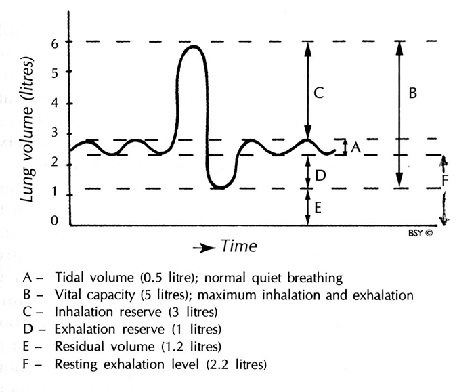Ordinary breathing is shallow. Shallow breathing means that we inhale and exhale a small amount of air in every breath. We take a large number of breaths per minute but each breath uses a small amount of air. Ordinary breathing thus is both shallow and fast.
Deep breathing on the other hand means a large amount of air inhaled and exhaled in each breath, but we breathe fewer number of breaths per minute. It may be counterintiutive to know that we supply a larger amount of usable air per minute by taking fewer breaths per minute. Generally, the smaller the number of breaths per minute, the larger the amount of usable air per minute.
The figure below shows the lung volume of an average person.
|
Figure showing maximum possible volume of air our lungs can breathe in one breath (A+C+D = 4.8 litres) and compares it with the volume of air in a normal quiet breath (A = 0.5 litre). Normally at rest, we have a minimum air of 2.2 litres in the lungs which can be reduced with full muscular effort be reduced in exhalation to 1.2 litres without collapsing the lungs. In the deepest breath we are capable, we can breathe in 4.8 litres, from 1.2 litres minimum to the full lung volume of 6 litres. |
The figure shows that in our ordinary resting breath, we breathe only 1/2 litre per breath while our full capacity is 4.8 litres per breath. To breathe 4,8 litres in a breath, we need to apply full muscular effort exercising all the primary and accessory muscles associated with breathing. Such an effort may only be possible for a short period of strenuous exercise and definitely not conducive to meditation.
Diaphragm is the primary muscle associated with lung volumes. Full use of this muscle is conducive to meditation. It is efficient in its use of energy. Its use is also the least distractive during the practice of meditation. Breathing occurs through the expansion of lungs in inhalation and contraction during exhalation. The use of the diaphragms is very effective in expanding and contracting the lungs necessary for breathing in and out large volumes of air per breath.
The video below shows the inflation and deflation of the lungs in breathing. Notice the extent to which lungs can expand when pushed to capacity.
